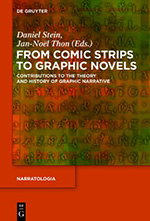Im Monitor werden in unregelmäßigen Abständen aktuelle Publikationen kurz vorgestellt, die für die Comicforschung relevant sein könnten. Die kurzen Ankündigungstexte dazu stammen von den jeweiligen Verlagsseiten.
Haben Sie Anregungen oder Hinweise auf Neuerscheinungen, die übersehen worden sind und hier erwähnt werden sollten? Das Team freut sich über eine Mail an redaktion@comicgesellschaft.de.

From Comic Strips to Graphic Novels
Contributions to the Theory and History of Graphic Narrative
Daniel Stein / Jan-Noël Thon (Hrsg.)
De Gruyter
416 Seiten
ISBN-10: 3110281813
ISBN-13: 978-3110281811
~€ 99,95
Juni 2013
This essay collection examines the theory and history of graphic narrative – realized in various different formats, including comic strips, comic books, and graphic novels – as one of the most interesting and versatile forms of storytelling in contemporary media culture. The contributions assembled in this volume test the applicability of narratological concepts to graphic narrative, examine aspects of graphic narrative beyond the ‘single work,’ consider the development of particular narrative strategies within individual genres, and trace the forms and functions of graphic narrative across cultures. Analyzing a wide range of texts, genres, and narrative strategies from both theoretical and historical perspectives, the international group of scholars gathered here offers state-of-the-art research on graphic narrative in the context of an increasingly postclassical and transmedial narratology.
Manga’s Cultural Crossroads
Jaqueline Berndt / Bettina Kümmerling-Meibauer (Hrsg.)
Routledge
270 Seiten
ISBN-10: 0415504503
ISBN-13: 978-0415504508
~€ 111,99
Mai 2013
Focusing on the art and literary form of manga, this volume examines the intercultural exchanges that have shaped manga during the twentieth century and how manga’s culturalization is related to its globalization. Through contributions from leading scholars in the fields of comics and Japanese culture, it describes “manga culture” in two ways: as a fundamentally hybrid culture comprised of both subcultures and transcultures, and as an aesthetic culture which has eluded modernist notions of art, originality, and authorship. The latter is demonstrated in a special focus on the best-selling manga franchise, NARUTO.
Narrative Structure in Comics:
Making Sense of Fragments
Barbara Postema
RIT Press
188 Seiten
ISBN-13: 9781933360959
~$29.95
Juni 2013
In Narrative Structure in Comics: Making Sense of Fragments, Barbara Postema seeks to explain how comics communicate and create meaning, with an emphasis on two aspects of comics. She first examines the pictorial quality of comics, which receives more emphasis than verbal/textual elements. Her second focus is upon the storytelling and narrative qualities of comics, as well as the literary explorations they provide. The “narrative structure” refers to the potential of images, the story telling capacities of panels, and the sequence of panels, in addition to the more traditional narratological concepts. Overall, the author presents a credible rationale for the way in which comics structure their narratives. At every level of communication, comics rely on gaps or absences to create meaning and guide the reader to a meaningful experience.
Superhelden-Cape und Krückstock?
Die Darstellung des Alterns im Comic „The Dark Knight Returns“
Tobias A. Müller
Diplomica Verlag
84 Seiten
ISBN: 978-3-8428-9339-9
~€ 19,50
März 2013
Das vorliegende Buch ist ein Beitrag zu einer erweiterten Betrachtung der Alter(n)sbildforschung, welcher insbesondere die gesellschaftliche Aufnahme und Wiedergabe von Vorstellungen hinsichtlich der Alterungsprozesse und des Alters an sich umfasst. Die Studie setzt sich zentral mit der Fragestellung auseinander, auf welche Weise das Alter(n) konstruiert wird. Erstmalig wird dabei die Perspektive auf die Comic-Literatur im Sinne einer umfangreichen, zusammenhängenden Narration gerichtet.
Geschichte lernen Nr. 153/154
Comics und Graphic novels
Peter Adamski et. al. (Hrsg.)
Friedrich Verlag
104 Seiten
ISSN: 0933-3096
~€ 31,00
Mai 2013
Unter dem Label Graphic novels sind die Bildergeschichten länger, thematisch komplexer und damit auch für andere Leserinnen und Leser ansprechender geworden. Aus diesem Grund eignen sich historische Graphic novels hervorragend dafür, mit Schülerinnen und Schülern die Konstruktion geschichtskultureller Produkte auf die Art ihrer Darstellung, ihre historische Triftigkeit und ihre Aussage intention zu überprüfen. Um diese Behauptung zu belegen, bindet diese Ausgabe neun ausgewählte Graphic novel-Auszüge und eine Ganzschrift in spannenden, kompetenzorientierten Geschichtsunterricht ein und liefert viele Anregungen für eine weitergehende Beschäftigung mit diesem unterhaltsamen Medium.
Slanted #17 –
Cartoon / Comic
Chefredaktion: Lars Harmsen, Uli Weiß
Slanted, c/o MAGMA Brand Design GmbH & Co KG
164 Seiten
ISSN: 1867-6510
~€ 14,00
März 2013
Parallel zum Typografie- und Designblog SLANTED, das die Möglichkeit zum direkten und fachlichen Austausch über Design, Typografie, Illustration und Fotografie bietet und zum Diskurs auffordert, widmet sich das monothematisch ausgerichtete Magazin SLANTED den Thematiken intensiver. Das Magazin wurde 2005 gegründet und widmet sich in jeder Ausgabe einem bestimmten typografischen Thema. Die Ausgabe Slanted #17 – Cartoon / Comic ist von vorne bis hinten diesen Erzählformen und ihren typografischen Eigenheiten verfallen.




